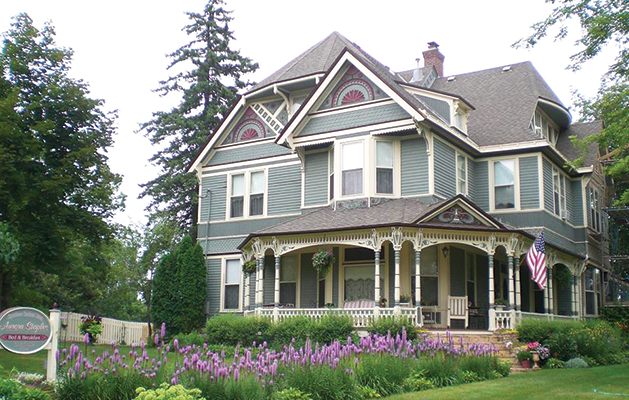
Stillwater’s identity is firmly rooted in history. One of the first cities in Minnesota, it boasts a nostalgic, bustling downtown and a well-preserved historic district. Its Boom Site, Prison Warden’s Home, and countless century-old homes and storefronts give locals and visitors a glimpse into the lives of past generations.
The city’s population has flexed dramatically along with industry, the economy and the American lifestyle. Established in the mid-1800s, Stillwater’s population skyrocketed to nearly 13,000 at the 1900 census, when lumber mills were plentiful and the St. Croix River was the town’s lifeblood. As industry and transportation changed, and the economy began a swift downturn, the population bottomed out at about 7,000 in 1940. Countless buildings were torn down as families were no longer able to maintain old homes, and businesses moved out.
Planning and zoning director Bill Turnblad knows the history of Stillwater well and is charged with maintaining the town’s functionality for today’s residents and attraction to future ones. He says in the late 19th century, the huge population was squeezed into half the area of the current city. Boarding and rooming houses were the norm, with workers and families moving often to follow work. Many homes were—and still are—used for nontraditional families and varying types of residents.
“What has really changed has been the makeup of families,” Turnblad says. “People have fewer kids now. And people used to have extended families or friends living together. Then in the 1940s, ’50s and ’60s, it was popular to chop homes into smaller units. Today we’re asking how to preserve these old homes for modern uses without dramatically changing the feel of neighborhoods.”
City planner Abbi Jo Wittman explains the late 1960s—when Stillwater hadn’t yet become such a suburb of the Twin Cities—was the turning point when citizens began caring more about preserving old homes and the historic character.
The catalyst Nelson School was structurally sound, but a buyer wanted to tear it down to put in more efficient, modern homes. An advocacy group put a stop to that, a symbolic shift after the city had lost its train depot and countless other historic landmarks. “Loss catalyzes change,” Wittman says. By the early 1990s, the city had established a downtown district and guidelines preserving pre-1946 buildings “significant to Stillwater’s history and character,” she says. Today, 113 homes are enrolled in the Heirloom and Landmark Sites Program, an effort by the city of Stillwater and Heritage Preservation Commission that supports property owners who maintain the historical character of their building or site.
The downtown is seeing a heyday again, with those same historic homes and buildings a key attraction. Stillwater is home to almost 20,000, with sprawling developments making it a fitting bedroom community for the Twin Cities. Homeowners look a little different than they once did, but a plethora of uses are springing up to make maintaining an old home more feasible for modern families—and keep downtown Stillwater an attraction to those living on the outskirts and beyond. And as that happens, Turnblad, Wittman and their team are out to preserve history but keep the town flexible to meet the needs of future generations. “We’re not about ‘dignifying’ or creating a false sense of history. What we want to do is actually preserve history,” Wittman explains.
One driver of community revitalization has been the rise in popularity of short-term rentals, which can provide homeowners with a side income from extra rooms or entire investment properties—or simply a way to make money when they’re away from home. A quick search turns up 85 Stillwater-area listings on the popular rental platform Airbnb, 23 on Vacation Rentals By Owner (VRBO) and 27 on homeaway.com. During Super Bowl weekend, one Stillwater residence was listed for $6,000 per night, offering a complimentary game-day limo ride and accommodations for 14.
Noting the potential changes brought on by this upswing, in 2017 the city formalized the oversight of short-term rentals, introducing an application process and capping permits at 35 Type A (hosted, where owners remain on-site), 35 Type B (unhosted, where renters take over a home or space while owners are away) and 15 Type C (dedicated, where owner-investors don’t live on-site) rental units annually. As of November 2017, 11 licenses had been granted, six B and five C.
“We’re really most concerned about the impact of rentals on residential neighborhoods,” Wittman says. “We’re trying to keep commercial uses separate from private, residential areas—but without rental income, many people can’t afford upkeep of these big, old houses.” Right now, she says about 1 percent of current homes in the village are rented in some capacity—and that often, allowing rentals makes it possible for homeowners to keep and maintain homes. Curb appeal is often improved to attract renters, which in turn inspires neighbors to make improvements.
“There’s a lot of peer pressure—if you see your neighbor painting and your home is peeling, it’s just a matter of time before you paint it,” Wittman says. “I hope that Stillwater would continue to be a place where people want to live, work and play—where that’s a financial possibility for people. Airbnb and VRBO help people garner a little income, but can also bring an amount of diversity—to keep communities thriving.”
Traditional bed-and-breakfasts have had a provision on the books for decades, providing a major segment of the rental accommodations in the village. “Our purpose for this house—besides to preserve the obvious history—is to keep it relevant,” says Erin Drews, co-owner of the Victorian Ann Bean Mansion on Pine Street. She and her husband Jeremy have renovated the home to bring it up to par with modern expectations for comfort, including top-quality food and fair-trade coffee, modern colors and vintage décor with an indulgent twist. “It’s fresh. People say, ‘Hey, it doesn’t smell old or musty in here!’ Ha. The tourism has helped us out, but we would have wanted to do what was best for the house anyway,” she says.
For the Drews, who live on-site, the home has been an avenue to build community and provide a unique experience to their visitors. Their home is at once a business, a nod to Stillwater’s storied past and a microcosm of the eclectic people who visit. “I’ve fallen in love with what this house means to the community, to our lives, to the people who visit here,” Drews says. Many traditional B&B owners, like the Drews, see other well-managed short-term rentals as a positive, one that increases tourism, support of local small businesses and options for visitors.
“I don’t think short-term rental is speculative,” Turnblad says. “It’s reactive. We like to do business online these days. Plus there’s a lack of inventory and choice in town, especially in the historic, downtown neighborhood. And that’s what people think of when they think Stillwater. We’re an event town, with a focus on weddings and reunions and gatherings like that. On those occasions, people want to come here and keep their groups together. Short-term rentals provide what hotels can’t.”
Todd Huntley took a different approach to home ownership. He bought a 5,000-square-foot, 1890s-era home on Third Street prior to the mortgage crisis and had to rethink how to use the space after the recession. He reconfigured the home to make it more useful for modern residents, while still keeping the Victorian character.
When he first moved into the neighborhood, he recalls getting a handful of trick-or-treaters, and now—with the restoration of the neighborhood and new business springing up around him—he gets hundreds. “People are decorating homes for Christmas, too,” he says, acknowledging short-term rentals are part of what’s bringing new life to old neighborhoods. But for him, it’s only part of the story. “Families are driving the change in our neighborhood, not rentals. But no matter the avenue, it’s so cool that people are going in and restoring the beauty of these old homes,” he says.









